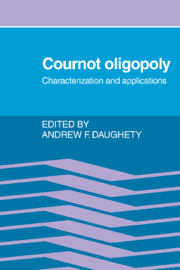Book contents
- Frontmatter
- Contents
- Preface
- Part I Introduction
- Part II Background
- Part III Examining Cournot's model
- 4 On the existence of Cournot equilibrium
- 5 Collusive behavior in noncooperative epsilon-equilibria of oligopolies with long but finite lives
- 6 A non-cooperative equilibrium for supergames
- 7 Reconsidering Cournot: the Cournot equilibrium is consistent
- 8 An experimental test of the consistent-conjectures hypothesis
- 9 Quantity precommitment and Bertrand competition yield Cournot outcomes
- 10 On the efficiency of Bertrand and Cournot equilibria with product differentiation
- 11 Price competition vs. quantity competition: the role of uncertainty
- Part IV Applications
6 - A non-cooperative equilibrium for supergames
Published online by Cambridge University Press: 07 September 2009
- Frontmatter
- Contents
- Preface
- Part I Introduction
- Part II Background
- Part III Examining Cournot's model
- 4 On the existence of Cournot equilibrium
- 5 Collusive behavior in noncooperative epsilon-equilibria of oligopolies with long but finite lives
- 6 A non-cooperative equilibrium for supergames
- 7 Reconsidering Cournot: the Cournot equilibrium is consistent
- 8 An experimental test of the consistent-conjectures hypothesis
- 9 Quantity precommitment and Bertrand competition yield Cournot outcomes
- 10 On the efficiency of Bertrand and Cournot equilibria with product differentiation
- 11 Price competition vs. quantity competition: the role of uncertainty
- Part IV Applications
Summary
Introduction
John Nash has contributed to game theory and economics two solution concepts for nonconstant sum games. One, the non-cooperative solution [9], is a generalization of the minimax theorem for two person zero sum games and of the Cournot solution; and the other, the cooperative solution [10], is completely new. It is the purpose of this paper to present a non-cooperative equilibrium concept, applicable to supergames, which fits the Nash (non-cooperative) definition and also has some features resembling the Nash cooperative solution. “Supergame” describes the playing of an infinite sequence of “ordinary games” over time. Oligopoly may profitably be viewed as a supergame. In each time period the players are in a game, and they know they will be in similar games with the same other players in future periods.
The most novel element of the present paper is in the introduction of a completely new concept of solution for non-cooperative supergames. In addition to proposing this solution, a proof of its existence is given. It is also argued that the usual notions of “threat” which are found in the literature of game theory make no sense in non-cooperative supergames. There is something analogous to threat, called “temptation,” which does have an intuitive appeal and is related to the solution which is proposed.
In section II the ordinary game will be described, the non-cooperative equilibrium defined and its existence established. Section III contains a description of supergames and supergame strategies.
- Type
- Chapter
- Information
- Cournot OligopolyCharacterization and Applications, pp. 142 - 158Publisher: Cambridge University PressPrint publication year: 1989
- 4
- Cited by

